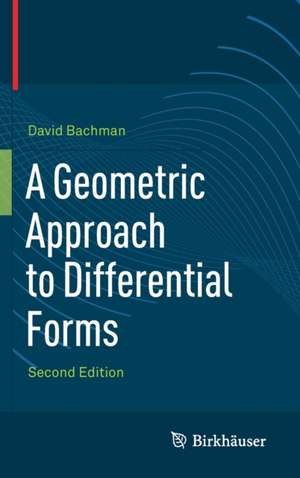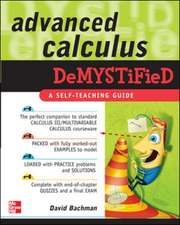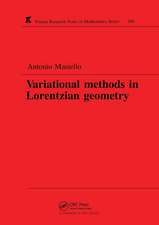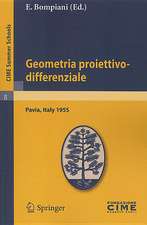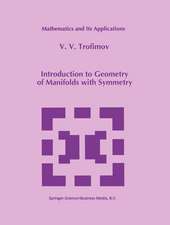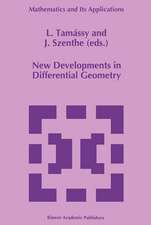A Geometric Approach to Differential Forms
Autor David Bachmanen Limba Engleză Hardback – 4 noi 2011
Each new concept is presented with a natural picture that students can easily grasp; algebraic properties then follow. This facilitates the development of differential forms without assuming a background in linear algebra. Throughout the text, emphasis is placed on applications in 3 dimensions, but all definitions are given so as to be easily generalized to higher dimensions.
The second edition includes a completely new chapter on differential geometry, as well as other new sections, new exercises and new examples. Additional solutions to selected exercises have also been included. The work is suitable for use as the primary textbook for a sophomore-level class in vector calculus, as well as for more upper-level courses in differential topology and differential geometry.
Preț: 421.55 lei
Nou
Puncte Express: 632
Preț estimativ în valută:
80.67€ • 87.60$ • 67.77£
80.67€ • 87.60$ • 67.77£
Carte tipărită la comandă
Livrare economică 22 aprilie-06 mai
Preluare comenzi: 021 569.72.76
Specificații
ISBN-13: 9780817683030
ISBN-10: 0817683038
Pagini: 156
Ilustrații: XVI, 156 p. 43 illus.
Dimensiuni: 155 x 235 x 17 mm
Greutate: 0.42 kg
Ediția:2nd ed. 2012
Editura: Birkhäuser Boston
Colecția Birkhäuser
Locul publicării:Boston, MA, United States
ISBN-10: 0817683038
Pagini: 156
Ilustrații: XVI, 156 p. 43 illus.
Dimensiuni: 155 x 235 x 17 mm
Greutate: 0.42 kg
Ediția:2nd ed. 2012
Editura: Birkhäuser Boston
Colecția Birkhäuser
Locul publicării:Boston, MA, United States
Public țintă
Lower undergraduateCuprins
Preface.- Guide to the Reader.-Multivariable Calculus.- Parameterizations.- Introduction to Forms.- Forms.- Differential Forms.- Differentiation of Forms.- Stokes' Theorem.- Applications.- Manifolds.- Non-linear Forms.- References.- Index.- Solutions.
Recenzii
From the reviews of the second edition:
“This book is a good complement to existing textbooks on vector calculus and shows a different view on classic material. It should be helpful to both physicists and mathematicians as an introduction to first concepts of the basic tools of modern theoretical physics, differential geometry, and topology.” (Vladislav Nikolaevich Dumachev, zbMATH, Vol. 1266, 2013)
“This book is a good complement to existing textbooks on vector calculus and shows a different view on classic material. It should be helpful to both physicists and mathematicians as an introduction to first concepts of the basic tools of modern theoretical physics, differential geometry, and topology.” (Vladislav Nikolaevich Dumachev, zbMATH, Vol. 1266, 2013)
Textul de pe ultima copertă
"[The author's] idea is to use geometric intuition to alleviate some of the algebraic difficulties...The emphasis is on understanding rather than on detailed derivations and proofs. This is definitely the right approach in a course at this level." —MAA Reviews (Review of First Edition)
"The book certainly has its merits and is very nicely illustrated … . It should be noted that the material, which has been tested already in the classroom, aims at three potential course tracks: a course in multivariable calculus, a course in vector calculus and a course for more advanced undergraduates (and beginning graduates)." —Mathematical Reviews (Review of First Edition)
The modern subject of differential forms subsumes classical vector calculus. This text presents differential forms from a geometric perspective accessible at the advanced undergraduate level. The author approaches the subject with the idea that complex concepts can be built up by analogy from simpler cases, which, being inherently geometric, often can be best understood visually.
Each new concept is presented with a natural picture that students can easily grasp; algebraic properties then follow. This facilitates the development of differential forms without assuming a background in linear algebra. Throughout the text, emphasis is placed on applications in 3 dimensions, but all definitions are given so as to be easily generalized to higher dimensions.
The second edition includes a completely new chapter on differential geometry, as well as other new sections, new exercises and new examples. Additional solutions to selected exercises have also been included. The work is suitable for use as the primary textbook for a sophomore-level class in vector calculus, as well as for moreupper-level courses in differential topology and differential geometry.
"The book certainly has its merits and is very nicely illustrated … . It should be noted that the material, which has been tested already in the classroom, aims at three potential course tracks: a course in multivariable calculus, a course in vector calculus and a course for more advanced undergraduates (and beginning graduates)." —Mathematical Reviews (Review of First Edition)
The modern subject of differential forms subsumes classical vector calculus. This text presents differential forms from a geometric perspective accessible at the advanced undergraduate level. The author approaches the subject with the idea that complex concepts can be built up by analogy from simpler cases, which, being inherently geometric, often can be best understood visually.
Each new concept is presented with a natural picture that students can easily grasp; algebraic properties then follow. This facilitates the development of differential forms without assuming a background in linear algebra. Throughout the text, emphasis is placed on applications in 3 dimensions, but all definitions are given so as to be easily generalized to higher dimensions.
The second edition includes a completely new chapter on differential geometry, as well as other new sections, new exercises and new examples. Additional solutions to selected exercises have also been included. The work is suitable for use as the primary textbook for a sophomore-level class in vector calculus, as well as for moreupper-level courses in differential topology and differential geometry.
Caracteristici
The second edition includes two additional chapters, focusing on the more advanced topics of the book Presents differential forms from a geometric perspective accessible at the sophomore undergraduate level Each new concept is presented with a natural picture that students can easily grasp; algebraic properties then follow Designed to support three distinct, classroom tested, course tracks Contains excellent motivation, numerous illustrations and solutions to selected problems Includes supplementary material: sn.pub/extras
